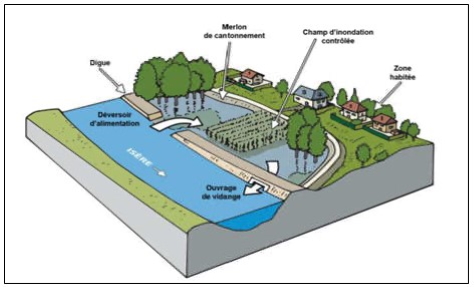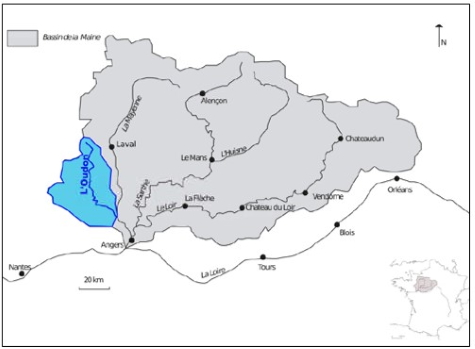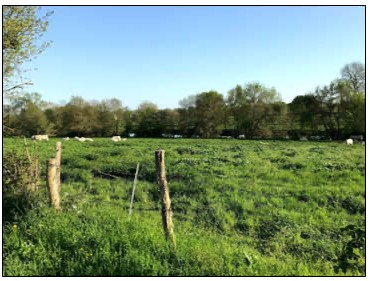

Article of the Month - April 2021 |
|
|
 |
| Marie Fournier | Mathieu Bonnefond |
This article in .pdf-format (11 pages)
This paper is mainly based on the results of the FARMaine project. The authors analyzes the consequences of environmental public policies on agricultural land and practices in the Maine river basin (Région Pays de la Loire).
In France, flood management policies have strongly evolved since the
1990s. Flood mitigation has become a key strategy in order to contribute
to the diversification and sustainability of flood risk management
policies (Larrue et al., 2015).
In this context, more and more river authorities launch and implement
floodplain restoration and water retention projects locally in France.
Like in most Western European countries, it is now taken for granted
that flood management requires ‘‘making space’’ for water by increasing
retention capacity of floodplains (Warner et al., 2012). However, in
many European countries, floodplain restoration still proves to be a
societal challenge (Moss, Monstadt, 2008) and rural land has an
important role to play in flood mitigation (Morris et al., 2010).
In this context, our presentation focuses on a specific legal mechanism – the over-flooding easement (“servitude de sur-inondation”) – created in France in 2003 in order to facilitate the implementation of floodplain restoration and water retention projects. Our research shows that more and more river and flood management institutions choose to use this public utility easement in order to control land uses and activities in the floodplains and avoid land acquisition. However, this legal tool may have important consequences for land uses and economic activities. We use the case of the Oudon river basin (Western France, (Mayenne/Maine-et-Loire)) and describe how river managers have succeeded, via local agreements, in building synergies between their own objectives (the restoration of floodplains and water retention areas) and farming activities impacted by the over-flooding easement.
In France, flood risk management (FRM) policies have strongly evolved since the 1990s. Flood mitigation has become a key strategy in order to contribute to their diversification and sustainability (Larrue et al., 2015). Flood mitigation measures aim at reducing the likelihood and magnitude of flooding; they are complementary to flood defense. They are being put in place through actions that accommodate (rather than resist) water, such as natural flood management or adapted housing (Fournier et al., 2016). Within this strategy, more and more river authorities, i.e. river syndicates or inter-municipalities competent for FRM, launch and implement floodplain restoration and water retention projects in France. Like in most Western European countries, it is now taken for granted that flood management requires ‘‘making space’’ for water by increasing the retention capacity of floodplains (Warner et al., 2012). However, in many European countries, floodplain restoration still proves to be a societal challenge (Moss, Monstadt, 2008) and rural land has an important role to play in flood mitigation (Morris et al., 2010).
In this context, our presentation focuses on a specific legal mechanism – the over-flooding easement (“servitude de sur-inondation”) – created in France in 2003 in order to facilitate the implementation of floodplain restoration and water retention projects. The over-flooding easement was created in order to contribute to floodplain storage and conveyance projects (identified as “making space for water” projects by Morris et al., 2016). Thanks to this public utility easement, river authorities can delineate and fix specific rules in water retention areas which have been equipped with hydraulic works. Our research shows that more and more river authorities choose to use this easement in order to control land use in the floodplain and avoid land acquisition. However, this legal tool may have important consequences for local land users and economic activities. As a result, negotiation processes are often launched in order to conciliate FRM objectives and other/former land uses.
This presentation is mainly based on the results of the FARMaine project (“Pour et Sur le Développement Régional” (PSDR4 Grand Ouest 2016-2020) Research Programme (www.psdrgo.org)). This project analyzes the consequences of environmental public policies on agricultural land and practices in the Maine river basin (Région Pays de la Loire). In this presentation, we mainly use the results coming from scientific and grey literature review, semi-structured interviews with institutional local stakeholders on the Oudon river basin and participant observation.
First we describe the national context in which the over-flooding easement has become a key procedure for local authorities in their projects to mitigate the flood risk. Then, we explain more in detail the legal mechanisms for this new public utility easement. In particular, we point out its advantages and limits for river managers. Eventually, we use the example of the Oudon river basin and focus on the negotiation processes and agreements which have been necessary for local authorities and private stakeholders to build synergies between FRM policies and the local economic activities impacted by the over-flooding easement.
If the over-flooding easement was introduced in the French law about
20 years ago, it took some years before French local authorities start
to use this legal instrument. Empirical research (Broussard, 2019) shows
that more and more French local authorities competent for flood and
river management have preferred this instrument to others (such as land
acquisition) during the last five years. In order to understand its
increasing use, it is important to recall that it has been concomitant
to two major evolutions in French FRM policies.
First, it is only since a decade or so that local authorities play an
increasing role and involvement in FRM policies in France. While FRM
used to be mainly dominated by the French central government
administration, new competences have been transferred to them by law
during the last years. In particular, the MAPTAM law (2014) conferred
them a new responsibility for water management and flood prevention
(so-called GEMAPI competence (GEstion des Milieux Aquatiques et
Prévention des Inondations)). This new competence was created in order
to facilitate the integrated management of water and floods issues at
local level. Within the MAPTAM Act, municipalities are clearly
identified as the key stakeholder in flood risk management. They hold an
exclusive and mandatory competence in this field. Even though they were
already responsible by law for water production and delivery, the MAPTAM
Act defines several new competences for them:
Protection and restoration of rivers and wetlands.
In practice, it is mainly via inter-municipal organizations (river
syndicates or intercommunalities) that French local authorities launch
flood mitigation projects to better deal with natural hazards (Fournier,
2019)
In this context, French local authorities are progressively investing the mitigation strategy within FRM policies. Among all FRM strategies (defense, preparation, recovery, prevention and mitigation as defined by Hegger et al., 2016), preparation, recovery and defense still remain strongly dominated by the French central government, but the mitigation strategy has been more and more invested by local authorities within the last decade. Indeed, it has become an opportunity for them to challenge and face the prevention rules imposed by central government in the Plans for Flood Risk Prevention (Plans de Prévention des Risques inondation (PPRi)), often considered as being too restrictive (Fournier et al., 2016). Since a decade or so, French municipalities or intercommunalities have started to launch mitigation projects addressing both hazard or vulnerability issues. Measures at property level (flood resilient housing) but also measures to better deal with natural hazards (flood storage areas such as presented in Figure 1, sustainable urban drainage, wetland creation or the restoration or river corridors) have been launched. Financial incentives were also created by the central government in order to promote mitigation projects at local level.

Figure 1 : schematic diagram of a flood
storage area
(source: Isère River Syndicate (symBHI))
To conclude, in a context of climate change and growing uncertainties about natural hazards, French local authorities are entitled to define new ways to deal with the flood risk. In this context, the over-flooding easement has become more frequently used in the implementation of mitigation projects dealing with the flood hazard. For French local authorities, this easement constitutes an opportunity, with limited financial investments, to improve local resiliency. As described in the following section, without any land acquisition, the over-flooding easement is implemented in order to control activities (and mainly farming) in flood retention areas.
In this section, we describe more precisely the mechanisms of this legal instrument. We also point out its advantages and limits for local authorities.
As stated previously, the over-flooding public utility easement was
created in 2003 with two other public utility easements (creation or
restoration of mobility areas in the riverbed and protection or
restoration of strategic wetlands). They are defined in article L.211-12
article in the French Environment Code.
This legal procedure was designed in order to facilitate the protection
of temporary water storage areas. It is important to point out that the
“over-flooding” easement can only be implemented in an area where the
retention capacity has been increased by hydraulic works (via the
construction of dams, dikes and so on). Therefore, the objective is to
increase flooding and store water in the upper part of a riverain basin,
in order to reduce floods and water run-off downstream and in urban
areas.
Such projects may have important direct and indirect impacts on
agricultural/farming land (increase of the water level and duration of
submersion, extension of the flood prone area and so on… (Ministère de
l’Agriculture et de l’Alimentation/Ministère de la Transition Ecologique
et Solidaire, 2018)).
Both central government administration and local public authorities may be at the initiative of this procedure but empirical research shows that this is mainly done by the latter (Broussard, 2019). The enforcement of this easement is quite complicated. First, a public inquiry must be conducted locally. The project is described and justified. A map of the area and the list of landowners must be settled. Complementary inquiries may be needed if hydraulic facilities are planned to increase water retention. Then, a decree taken by the local representative of the central government, the prefect (Préfet), identifies the perimeter and parcels concerned by the easement.
There are various consequences for landowners and tenants. The decree may impose a preliminary declaration for any new hydraulic project that could reduce or limit water retention in the future. Landowners and tenants must also give permanent access to their land for the public agents in charge of the maintenance of the water retention area. If the central government administration or local authorities own and rent agricultural land in the perimeter, they can impose binding clauses to the tenants in order to prevent damages when leases are renewed. Some compensations were created by the 2003 “Risks” Law. First, financial compensations are paid by the procedure holder to landowners, when prejudices are direct and certain. Tenants (mainly farmers) may also receive financial compensations in case of damage on buildings (but not always for crops or livestock losses). Landowners may also impose the acquisition of their land by the procedure holder (“droit de délaissement”). In 2003, the “Risks” Law also gave the possibility for local authorities to use their pre-emptive right to buy land in the perimeter of the easement (Struillou, 2012).
In a nutshell, river restoration and flood mitigation projects have often proved to be conflictual along rivers in France and their holders must define specific strategies to control land uses (Bonnefond et al., 2017). This new procedure is an opportunity for local authorities to avoid drastic land tenure measures, such as land acquisition, as it used to be more common a decade ago (Bonnefond, Fournier, 2013). Costs and negotiation processes are limited (as there is no acquisition), former land uses can be maintained but they are controlled. However, it is also important to point out some limits. Such projects often lead to an increase of the flooded area locally, a decrease of the land value and the necessity for their holders to organize discussions with landowners and tenants about financial or material compensations. At last, it is important to recall that such easement is permanent. It implies that any future purchaser of the land must adhere to the easement.
Therefore, even though the over-flooding easement presents less constraints than other legal instruments for the institutional holders, in practice, it still implies discussion and negotiation between all stakeholders involved locally and must be often combined with other instruments. In the last section, we illustrate with a case study (on the Oudon river basin) and describe how negotiation and arrangements with local farmers have been necessary to successfully implement this procedure.
As we can see in Figure 2, the Oudon river basin is located in the Western part of France (Maine-et-Loire/Mayenne Departments). The Oudon river basin is mainly rural and dominated by farming activities. Extensive grazing still remains in the bottom valleys but crop production is increasing. Figure 3 gives an overview of typical landscape in the Oudon bottom valleys.

Figure 2: The Oudon river basin, in the
Western part of France
(credits: M. Bonnefond, 2018)

Figure 3: Meadows in the Oudon bottom
valleys/Segré en Anjou
(credits: A. Debray, 2018)
In France, local authorities and river syndicate on the Oudon river basin were pilot in the implementation of this new type of public utility easement. In the beginning of the 2000s, after several major floods and major damages on hundreds of houses, they decided to create flood storage areas; in their project, they quickly faced the land tenure issue. Two options were considered: land acquisition or the implementation of a new procedure, the over-flooding easement. As explained during our interviews, local authorities decided to choose the latter, in order to avoid/limit conflicts with farmers.
Several perimeters were settled in the southern part of the river basin for the enforcement of the over-flooding easement first. Since then, 12 perimeters have been delineated in total (the largest perimeter is about 45 hectares). Locations were identified by the river syndicate in cooperation with central government administrations and the Chambers of Agriculture at local level (Maine-et-Loire and Mayenne Départements). The river syndicate bought the parcels where hydraulic works had to be built and the perimeters of the over-flooding easement delineated the flood-prone areas.
Financial compensation, for both land owners and tenants, quickly became a key issue. If the the river syndicate first considered the parcels of little value, the Chambers of Agriculture battled to increase compensations. In 2003, a first “agreement for compensation of land owners and tenants” was signed, even before the enforcement of the over-flooding easements. A 10% offset based on the land value was paid to owners and financial compensations were also planned for tenants in case of damages on crops, livestock and material goods (Debray et al., 2019).
It is important to point out that local farmers also had the opportunity to participate in the negotiation process. Since then, the Oudon river syndicate forecasts about 20 000 euros every year to compensate farmers.
The Oudon river syndicate had to face several difficulties and oppositions, even though the Chambers of Agriculture were partners and involved in the choice and design of this strategy; some perimeters were abandoned because of local oppositions. The farmers, fearing the economic and sanitary impacts of repeated floodings, as well as the constraints on land farming, regularly contested the projects during public meetings or meetings with the syndicate. If the Oudon river basin was an early and pilot project, some authors describe similar issues on other French river basins. On the Brévenne and Turdine river basin, Riegel (2018) describes very finely how compensations have been negotiated and calculated in agreement between the river syndicate holding the project for the local authorities and professional organizations defending the farmers’ interests. In particular, she explains that indemnities have been calculated differently for each farmer, taking into account the specific situation of each of them.
To conclude, the over-flooding public utility easement has progressively become an important legal instrument for French local authorities in the implementation of their mitigation projects dealing with the flood hazard. In the years to come, the over-flooding of rural and agricultural land may become more common in France to better protect urban areas downstream. In this presentation, we pointed out the advantages and limits of this procedure, which remains quite new and still under experiment in many river basins. Local authorities tend to avoid land acquisition and choose this procedure, which has permanent legal consequences on land rights though. From our empirical investigation, it appears that local negotiations constitute a key step in its implementation and in the delimitation of perimeters. These steps cannot be avoided by the institutional authorities in charge of such projects. Unlike stated at the premises of the years 2010 by some authors, landowners and tenants are far from being passive in its proceedings and do not only bear the consequences of the easement (Moliner-Dubost, 2013). They are consulted during the public inquiry and most of all their involvement is crucial in the definition of the perimeter and conditions of implementation (compensations, constraints on land uses) of the easement. Empirical investigation shows that local authorities often prefer to abandon projects if they do not reach an agreement locally. Beyond the legal dimension of such procedure, institutional holders must legitimate the flooding of rural land in the benefits of cities and integrate the local socio-economic issues at stake.
Bonnefond, M., Fournier, M., Servain, S., Gralepois, M., 2017, « La transaction foncière comme mode de régulation en matière de protection contre les inondations. Analyse à partir de deux zones d’expansions de crue : l’Île Saint Aubin (Angers) et le déversoir de la Bouillie (Blois) », Revue Risques Urbains / Urban Risks, Vol 17- 2, ISTE Editions.
Bonnefond M., Fournier M., 2013, « Maîtrise foncière dans les espaces ruraux. Un défi pour les projets de renaturation des cours d’eau », Economie rurale, n°334, p. 55-68.
Broussard, F., 2019, Préservation et gestion de la multifonctionnalité dans les Zones d'Expansion de Crues : le cas du bassin de la Maine, Mémoire de fin d’études, École Supérieure des Géomètres et Topographes (Le Mans).
Debray, A., Fournier, M., Bonnefond, M., 2019, “Quels outils pour concilier au mieux agriculture et gestion du risque d’inondation ? Mise en oeuvre et effets de la servitude de sur-inondation sur les pratiques agricoles dans les fonds de vallée”, 13èmes Journées de la Recherche en Sciences Sociales, Société Française d’Economie Rurale, Bordeaux, 11-13 December 2019.
Fournier, M., 2019, “Flood Governance in France. From Hegemony to Diversity in the French Flood‐Risk Management Actors' Network”, in Lajeunesse, I., Larrue, C., Facing hydrometeorological extreme events: a governance issue, Wiley.
Fournier, M., Larrue, C., Alexander, M., Hegger, D.L. T., Bakker, M.H.N., Pettersson, M., Crabbé, A., Mees, H., Chorynski, A., 2016, “Flood risk mitigation in Europe: how far away are we from the aspired forms of adaptive governance?”, Ecology and Society, 21(4):49. https://doi.org/10.5751/ES-08991-210449
Hegger, D. L. T., Driessen, P.P.J., Wiering M., Van Rijswick
H.F.M.W., Kundzewicz Z.W., Matczak P., Crabbé A., Raadgever G.T., Bakker
M. H. N., Priest S. J., Larrue C., and Ek K, 2016, “Toward more flood
resilience: is a diversification of Flood Risk Management strategies the
way forward?” Ecology and Society, 21(4):52.
https://doi.org/10.5751/ES-08854-210452
Larrue C., Bruzzone S., Lévy L., Gralepois M., Schellenberger T., Trémorin J-B., Fournier M., Manson C., Thuilier T., 2015, Analysing and evaluating flood risk governance in France. From state policy to local strategies, STAR-FLOOD (FP7/2007-2013).
Ministère de l’Agriculture et de l’Alimentation/Ministère de la Transition Ecologique et Solidaire, 2018, Prise en compte de l’activité agricole et des espaces naturels dans le cadre de la gestion des risques d’inondation: guide destine aux acteurs locaux. Volet activité agricole – version 2, 124p.
Moliner-Dubost, M., 2013, “Le destinataire des politiques environnementales”, Revue Française de Droit Administratif, p. 505 et s.
Morris, J., Hess, T.M., Posthumus, H., Agriculture’s role in flood adaptation and mitigation – policy issues and approaches, Sustainable Management of Water Resources in Agriculture, OECD, Paris.
Morris, J., Beedell, J., Hess, T.M., 2016, “Mobilising flood risk management services from rural land: principles and practice”, Journal of Flood Risk Management, volume 9, p. 50-68.
Moss, T. Monstadt, J., 2008, Restoring Floodplains in Europe: Policy contexts and project experiences, IWA Publishing.
Riegel, J., 2018, « Le dialogue territorial au risque de l’écologie? Traces et effets d’une concertation entre aménagements hydrauliques et restauration écologique », Participations, N° 20, 1, p. 173-198.
Struillou, J.-F., 2012, “Droit de preemption et prevention des risques”, Actualité Juridique Droit Administratif, p. 1329 et s.
Warner, J., Edelenbos, J., Van Buuren, A., 2012, Making space for the river: governance challenges. Making Space for the River. Governance Experiences with Multifunctional River Flood Management in the US and Europe, IWA Publishing.
Dr Marie Fournier is Assistant Professor in Urban and Land Planning at the National Conservatory of Arts and Crafts (Conservatoire National des Arts et Métiers- CNAM). In 2010, her PhD focused on public participation in flood risk management policies. She is scientific coordinator of the FARMaine research project (financed by the research programme "On and For Regional Development" : www.psdr.fr). She is involved in research projects which analyse the implementation of river and wetland management policies in France. She has a specific focus on local governance and the involvement of private stakeholders in public policies. In her research, she is also interested in the design and implementation of public instruments, local arrangements and their consequences on land uses and land use rights.
Dr Adèle Debray holds a PhD in Urban and Land Planning (University of
Tours, 2015). She was post-doc researcher in the FARMaine research
project (www.psdr.fr). Her research
focuses on environmental policies and more specifically nature
conservation policies.
Dr Mathieu Bonnefond holds a PhD in Urban and Land Planning (University
of Tours, 2009). He is Assistant Professor in Land Planning at the
National Conservatory of Arts and Crafts (Conservatoire National des
Arts et Métiers - CNAM) and director of the european LTER (Long Term
Environmental Research) "Zone Atelier Loire". Most of his research is
related to the analysis of river management, environmental public
policies and land management.
Marie Fournier
Laboratoire Géomatique et Foncier (EA4630), CNAM/HESAM
Ecole Supérieure des Géomètres et Topographes
1, boulevard Pythagore
72000 Le Mans
FRANCE
Tel. 0033 2 43 31 31 39
Web site: www.cnam.fr